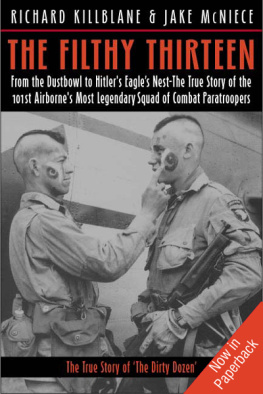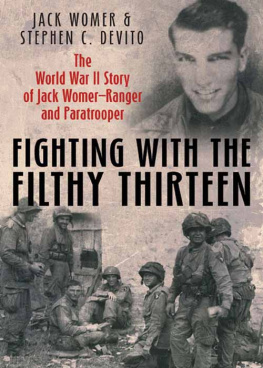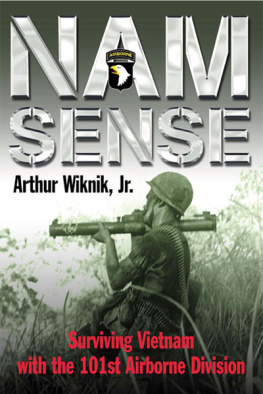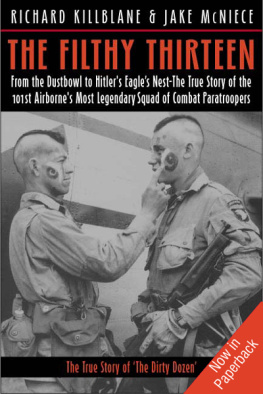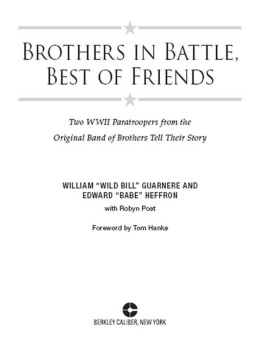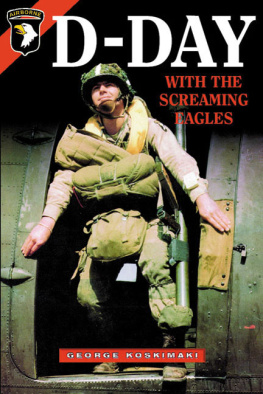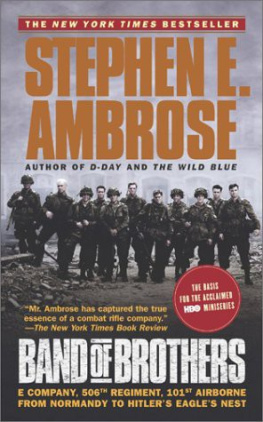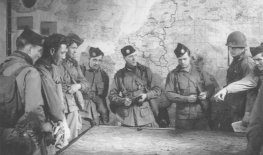

Published by
CASEMATE
908 Darby Road, Havertown, PA 19083
United States of America
and
17 Cheap Street, Newbury, Berkshire, RG14 5DD
United Kingdom
2003 by Richard Killblane
Reprinted September 2010
All rights reserved. No part of this publication may be reproduced, stored in a retrieval system or transmitted, in any form or by any means, electronic, mechanical, photocopying, recording or otherwise, without the prior permission of the publishers.
Typeset and design by K&P Publishing.
Hardcover Edition: ISBN 978-1-932033-12-0
Paperback Edition: ISBN 978-1-932033-46-5
Digital Edition: ISBN 978-1-935149-81-1
Cataloging-in-Publication data is available from the Library of Congress
P RINTED AND B OUND IN THE U NITED S TATES OF A MERICA .
P REFACE
I had known of Jake McNiece for a number of years before I considered writing his story. He and a friend, Truman Smith, were favorite guest speakers at local schools and social organizations, and both were always willing to speak at any veterans event I coordinated. Both of them truly gifted speakers, Truman finally put his own words into print with The Wrong Stuff: The Adventures and Mis-Adventures of an 8th Air Force Aviator. It was subsequently at the urging of Jakes friend and fishing buddy, Richard Sherrod, that I agreed to personally record Jakes own version of the war.
Sherrod, probably the biggest fan of World War II veterans, originally had a notion that every soldiers story should be recorded, though without realizing exactly how much work oral history entailed. Yet it was thanks to his encouragement that with Jake I finally took the first monumental step. The hours of effort required far exceeded my initial expectation, but I was overwhelmed with what I discovered. I had heard Jake speak to audiences before, but in one-on-one sessions I encountered the full uncensored version. With me as his sole audience, I was at the mercy of his unique talent for storytelling. Jake has a way of leaning back with his laugh; that grin just spreads across his face. He looks at you with that gleam in his eye and knows when and how long to pause before hitting you with his punch line. At times, he fed on my laughter. Sherrod, who had also heard all the stories fit for print, again became instrumental when I sat down to chronicle the accounts to see if I had missed anything. With his help I recorded them all.
Jake is one of the most gifted storytellers I have known. This is not to imply that any of his descriptions are untrue, but only to say that he is a skillful practitioner of the American art of first-person narrative that extends back to the days of Davy Crockett. This tradition continued with Samuel Watkins after the Civil War and Samuel Clemens (later Mark Twain), and in that same eighteenth century the famed frontier trapper and army scout, Jim Bridger, who attracted people from as far away as Europe to hear him spin his yarns of adventure. Storytelling is a talent which takes lifes experiences and relates them in an interesting manner. Like a fairy tale they often have a moral at the end, or like a joke they end with a punch line. There is no way I could ever tell the story of the Filthy 13 better than the man who inspired and led it. Even when Jakes words are captured in black and white they do not quite convey his gifted original style.
After innumerable interviews to record Jakes personal recollections, the second part of my task was to ground his accounts in the context of the broader campaign in World War II Europe, and to crosscheck them with the stories of other survivors of the Filthy 13, or men who fought alongside them. On occasion I have placed the stories of other veterans within Jakes narrative in order to flesh out events. More commonly, the additional context and analyses are in footnotes for each chapter.
There are places where Jakes memory of an incident differs in varying degrees from other veterans or what has been described by official histories. For anyone searching for the truth, no matter how fresh the memory or how recent the event, versions are going to differ depending on the perspective of the individual and what he felt was important. For example, Virgil Smith and Jake McNiece, who both live in Ponca City, Oklahoma, tell nearly identical versions of the same stories, though with different emphases. When Jake ate in the officers mess in England, Jake concludes with how Virgil introduced him as a major. That was funny enough for Jake. Since Virgils neck was on the line if Jakes cover was blown, he finished with the fact that Jake kept going back to the mess. Otherwise the stories were identical. By and large, the accounts from the various veterans of Regimental Headquarters Company were similar.
I have benefited from the fact that following the 1979 101st Airborne Division Reunion, the veterans of the company began to hold their own annual get-togethers. At these they told and retold stories, allowing me to compare accounts and often gain greater detail. While Jack Agnew and Jake are reputed to have the best memories in the unit, their stories differ more in the details. Jack lives in Pennsylvania and Jake in Oklahoma. On average they meet once a year at the reunions and communicate a little more on the phone. Without a doubt this storytelling process by the group has had influence on the similarity of the stories and it has also helped validate the events. In some ways the telling of war stories at the reunions filled in lost details by others and performed the function of the long awaited group after-action review.
Jakes narration is not just another view of the war through the eyes of a paratrooper. Jake and the Filthy 13 played key roles in some of the critical battles of the war. At first it may be hard to believe that any one unit could have been in the thick of so much combat, but one must remember that the Filthy 13 was one of only three demolition-saboteur sections in the 506th Parachute Infantry Regiment. Unlike other infantrymen, they received special missions in accordance with their training, such as wiring or removing demolitions from bridges, or clearing mines and booby traps, all at the forefront of the attack. On top of that, their transfer to the Pathfinders and fortune would place these men in the path of even greater adventure.
After interviewing other members of his company, including two of his company commanders, Hank Hannah and Gene Brown, I found that Jakes reputation has if anything exceeded his personal estimation. Although he was but one of the many interesting characters in Regimental Headquarters Companyand for that matter, the entire 506th Regimenthe may well have been the wildest. This was in no small measure due to his sometimes anarchic sense of humor. In addition, almost everyone agreed that Jake was the toughest man in the company.
When comparing Jakes and other company veterans stories with the official histories there are significant discrepancies. Jakes account of the fight on the bridges on the Douve Canal below Carentan differs from the official report compiled by the History Division under S. L. A. Marshall. Marshall, himself the pioneer of the group interview, has come under criticism for not being uniformly accurate in his research, particularly regarding the maelstrom of airborne melees during the Normandy campaign. Marshall admitted to historian Mark Bando that he did not use the group interview on the action at the Brevands bridgehead but instead referred to official reports. From the writings it appears that the officer who commanded the action at the bridge, Captain Charles Shettle, may at least have been consulted.

